After one season at the Varsity Arena, with an absurdly small capacity of 4,800, the Toros were able to strike a deal for the 1974-75 season to play at Maple Leaf Gardens, but unfortunately for the Toros, the Maple Leafs owner Harold Ballard was now out of prison and back in control of the Gardens, and Ballard, as cantankerous a man who ever lived, hated the rival WHA for signing away many of his players. Hated it. And that hatred was taken out on the Toros at every opportunity.
For example, the lease called for the Toros to pay $15,000 per game to play at the Gardens, but when the first game came, the arena was quite dark and Ballard then demanded and additional $3,500 for the use of the lights! He also denied the team access to the Maple Leaf's locker room, forcing the Toros to build their own at a cost of $55,000. Ballard even took the cushions off of the players bench, saying the Toros could buy their own!
The Toros still gave it their best effort despite the off-ice headaches, and signed Canadian hero Paul Henderson away from the Maple Leafs, obviously earning no favors from his previous employer Ballard, as well as former Maple Leaf and Canadian star Frank Mahovlich and Czechoslovakian defector Vaclav Nedomansky. Attendance rose to 10,000 fans a game but the Toros were dumped in the opening round of the playoffs by the San Diego Mariners in six games.
For the 1975-76 season, the Toros signed underage junior Mark Napier as a tactic to obtain the best young players before the NHL could, as the established league had rules in place that did not allow players under the age of 20. Nedomansky set Toros records with 56 goals and 98 points in 1975-76, while Napier shown with 43 goals and 93 points, followed by Mahovlich's 34 goals and 89 points. The positive news ended there however, as the team dropped like a rock in the standings, finishing a dismal 24-52-5, last in the Canadian Division and one of the two out of 12 teams who finished the season to not qualify for the playoffs.
The poor performance on the ice resulted in a 20% attendance drop, which combined with the difficulties in dealing with their landlord Ballard, caused ownership to make the bizarre choice to relocate the team once more, only this time to the deep south of the United States to Birmingham, Alabama of all places, a city with zero previous hockey history or connections.
For the 1976-77 season, the club was renamed the Birmingham Bulls, which allowed it to keep the same logo. In Birmingham, aside for being known for its policy of signing yet more underage junior players, the club also became known for their players frequent use of their fists...
Seemingly more inclined to fight than score in order to attract fans to the unknown spectacle of ice hockey, the Bulls led the WHA in penalty minutes twice, most often earned in increments of 5 and 10 minutes at a time!
During their first season in Birmingham, the Bulls were led in scoring by the 19 year old Napier, who was a one man show for the club, scoring 60 goals and 96 points, far outdistancing Nedomansky's 36 goals and 69 points. Napier's 60 goals were third most in the league that year. Lou Nistico had 166 penalty minutes in 79 games to lead the team while contributing 20 goals and 56 points. Gilles "Bad News" Bilodeau was second with 133 minutes but in only 34 games, a pace that would have led the league had he played a full season.
Their goaltending was mainly handled by John Garrett, who the Toros rescued from the roster of the Minnesota Fighting Saints, who had folded during the 1975-76 season. Garrett won 24 of the Bulls 31 wins with a 3.53 goals against average.
The Bulls finished last in the Eastern Conference with a 31-46-4 record for 66 points, ten out of the final playoff spot.
For the 1977-78 season, the club signed Ken Linseman as an underage player, but also made heads turn when, under the guidance of new head coach Glen Sonmor, they rounded up a (literally) Slap Shot movie worthy riotous line up of Steve "Mental Case" Durbano (284 penalty minutes), Frank "Never" Beaton (279), "Bad News" Bilodeau (258) and Dave "Killer" Hanson, one of the Hanson Brothers from Slap Shot, with 241 minutes as the quartet finished 1-2-3-4 in league penalty minutes!
"We had a fellow by the name of Frank "Never Been Beaten" Beaton and he would throw ten punches before you knew you were in a fight with him," Mahovlich recalled. "So it was pretty fast and you didn't know what was happening. Gilles Bilodeau, he was a huge man from northern Quebec. A real lumberjack. A nice person though. A nice, gentle person, but he was down there for one thing. The coach would send him over the boards for one thing, and boy, he did his thing. I don't know if he ever won a fight, but he certainly got into a lot."
With the top four penalty minute leaders, the Bulls, not unexpectedly, led the WHA with 2,177 total penalty minutes, 476 more than the next closest team and more than twice the Winnipeg Jets 988. The 1,189 minute difference between the two clubs was the equivalent of an entire five man lineup spending four full games in the penalty box!
The aging Mahovlich was put on a line with tough guys Beaton and Hanson. Naturally, his point production plummeted like a rock - from 89 points in 1975-76 in Toronto to 38 points with the Bulls in 1977-78. When asked by a reporter what was wrong, Mahovlich brilliantly replied, "I don't know, but I seem to play better with Gordie Howe and Alex Delvecchio."
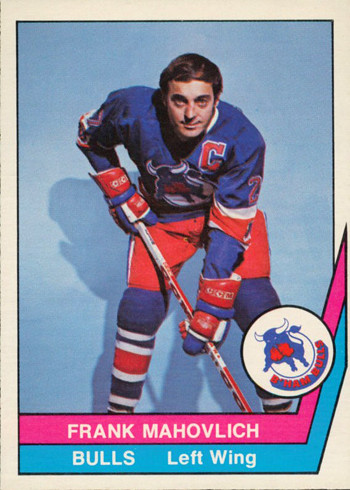
Frank Mahovlich went from starring Montreal, Detroit and Toronto to somehow playing in Birmingham, Alabama in the crazy world of the WHA
In one of many infamous incidents, Hanson once inadvertently ripped the toupee off of WHA superstar Bobby Hull during yet another Bulls melee! Mahovlich recalls. "He jumped up behind Hull and pulled Hull's wig off. And in those days, the wigs were sewn in. They were stitched into your head. And Bobby started to bleed from the top down and the blood was coming all over. It happened so quick. I don't know what he was doing, he just did it."
That wasn't the end of the story either. "Then, after the game, I recall Linseman, Durbano and I were walking out from the rink and we were going back to the hotel and Durbano kicks this fellow that was voicing his opinion at him and a fight breaks out right outside our dressing room. This fellow is a tough guy, but you don't know that when a fellow is in a shirt and tie. You don't know whether he is tough or not. So the fellow puts Durbano down and our coach Sonmor runs into the room and yells: "Durbano is getting the living hell beat out of him." Six guys come out of the dressing room with no clothes on, they were still in the shower, and we got a hundred spectators there. We have six guys pulling this fellow off. It was really out of Slap Shot. It was better than Slap Shot. This was the WHA."
Once again, a 19 year old led the club in scoring, this time Linseman, who had 38 goals and 76 points while adding 126 penalty minutes of his own behind the top four. Peter Marrin was next with 28 goals and a team leading 43 assists for 71 points while both Henderson (37) and Napier (33) had over 30 goals along with Linseman.
The club improved slightly to 36-41-3 for 75 points to finish sixth in the WHA out of eight teams. They were paired against the Winnipeg Jets in the opening round of the playoffs and lost two in Winnipeg 9-3 and 8-3. They returned home and won Game 3 by a score of 3-2 with center John Stewart getting the game winner on a second period power play from Dave Gorman and penalty minute king Durbano(!) for the only playoff win in franchise history, as they would lose the next two 5-1 and 5-2 on their way to being outscored 29-12 in five games.
While the club had dabbled in the underage player market previously, they went all in for 1978-79 in the last, desperate days of the WHA. Owner John Bassett was expecting a WHA merger with the NHL following the 1977-78 season and a nice payment to compensate for folding his team, as Birmingham was never going to a part of any NHL expansion.
The Bulls had lost 2,000 season ticket holders after having averaged 8,300 fans and Bassett had sold off Linseman, Napier and Garrett in anticipation of winding up operations, but when the expected merger fell through, he needed a half a dozen players quickly and cheaply, and Bassett had a plan.
Teenager Rick Vaive was signed as a free agent out of Canadian junior hockey who had scored 76 goals for Sherbrooke. He led Birmingham in both scoring, with 59 points, and penalty minutes with a league leading 248.
Vaive was one of eight underage players on the Bulls roster that season, which earned the club the nickname of the "Baby Bulls". The other seven to join Vaive were Craig Hartsburg, Rob Ramage and Gaston Gingras on defense, goaltender Pat Riggin and forwards Louis Slegher, Keith Crowder and Michel Goulet. Goulet was the team leader in goals with 28 followed by Vaive and Slegher with 26 with Henderson next with 24 at nearly twice the age of the other three at 35 years old.
Following Vaive in penalty minutes was returnee Hanson at 212 followed by another Baby Bull, Ramage, with 165. The 19 year old Riggin split the goaltending duties with Ernie Wakely, who at age 37 was the oldest player on the club.
The Bulls record slipped to 32-42-6 for 70 points, last among the 6 teams that made it through the entire season and the only one to not qualify for the playoffs. The Bulls final game came on this date in 1979, a heartbreaking 5-4 overtime loss to the Jets, as a win would have tied the Bulls with the Cincinnati Stingers for the final playoff spot.
Bassett did get $2.85 million when the agreement was eventually made to admit four of the desirable WHA survivors into the NHL, the Edmonton Oilers, Quebec Nordiques, Hartford Whalers and the Jets, which meant the end of the Stingers and the Bulls. Sort of.
Birmingham actually remained in business and joined the Central Hockey League for a season and two-thirds before disbanding before the 1980-81 season was complete.
Henderson, who played all three seasons in Birmingham, was the team's all time leader in games played with 237, and in points with 165. Napier had 93 goals in two seasons, besting Henderson's 84, while Hanson was the penalty minute champ with 453 in two seasons ahead of Bilodeau's 391.
Defenseman Ramage was the first overall selection, going to the Colorado Rockies. Vaive was chosen with the fifth pick by the Vancouver Canucks with Hartsburg taken with the next selection by the Minnesota North Stars. Goulet lasted until the 20th pick when he went to the Nordiques. Gingras was chosen by the Montreal Canadiens 6th in Round 2, 27th overall and Riggin became the first goaltender selected as the 33rd pick by the Atlanta Flames as the Baby Bulls were eagerly claimed by the NHL.
Many of the Bulls players would go on to have productive NHL careers, with Goulet, Rod Langway and Mahovlich all eventually being inducted into the Hockey Hall of Fame.
Today's first featured jersey is a 1976-77 Birmingham Bulls Peter Marrin jersey as worn during the Bulls first season in Birmingham. The Bulls wore this jersey style dating back to their days as the Toronto Toros starting in 1973-74.
When the team moved to Birmingham for the 1976-77 season, the only change to their jerseys was the removal of the "Toros" wordmark from the sleeve stripes. Note the block font for the name and the three color numbers created by sewing the red onto the white layer with blue thread.

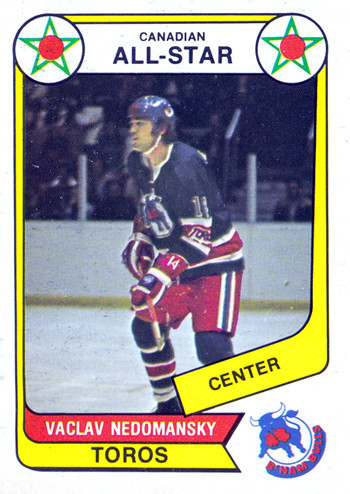
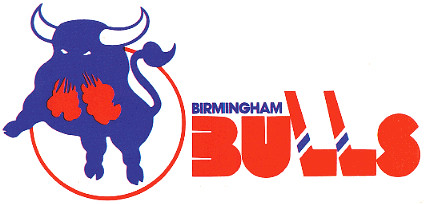
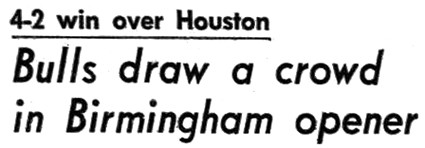
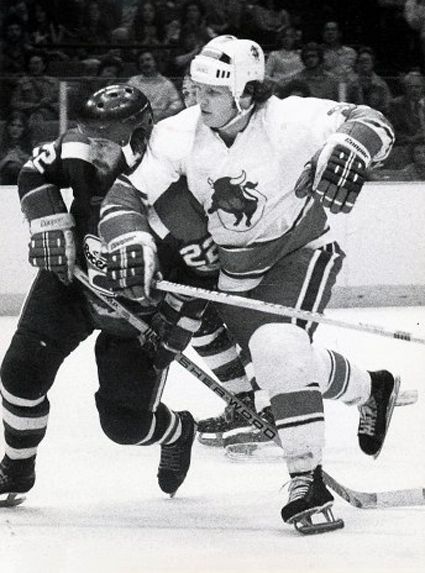
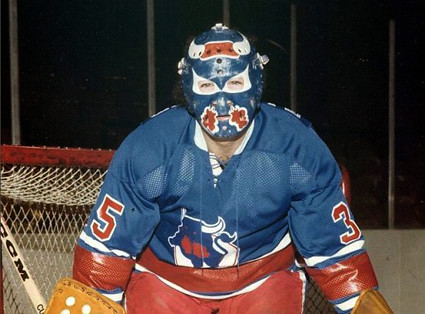
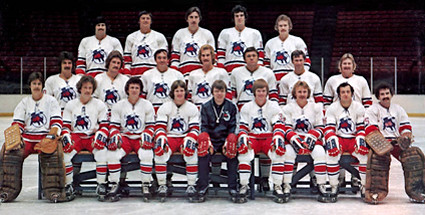
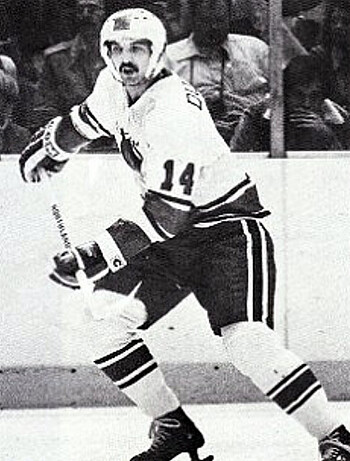
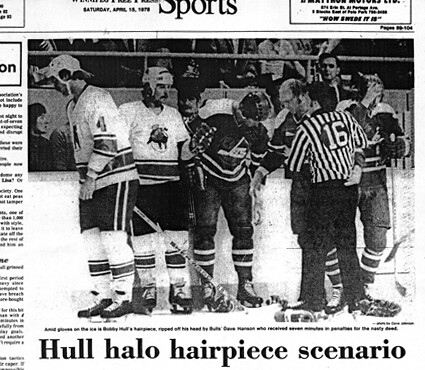
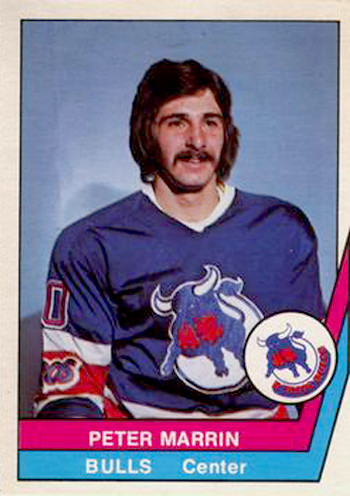
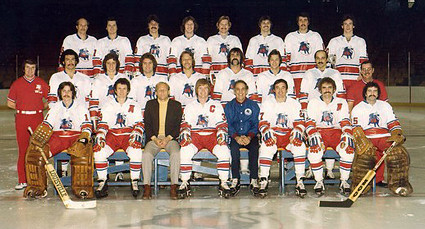
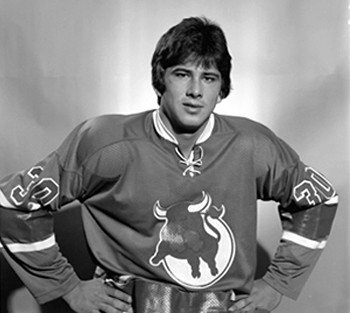
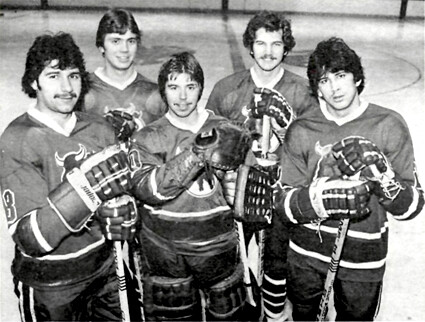
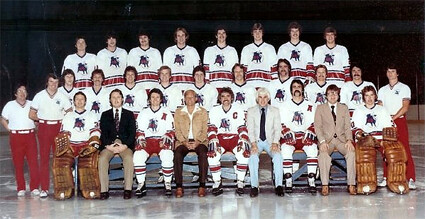
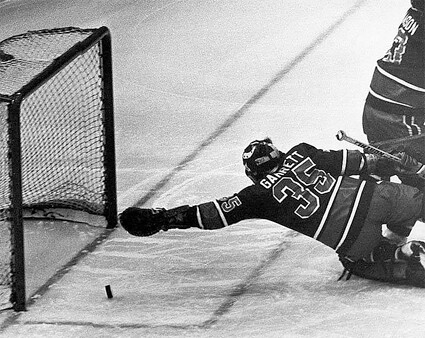
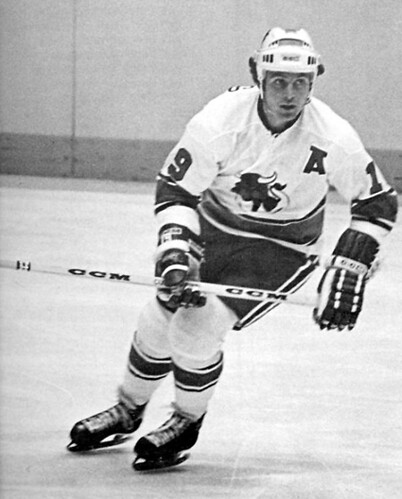
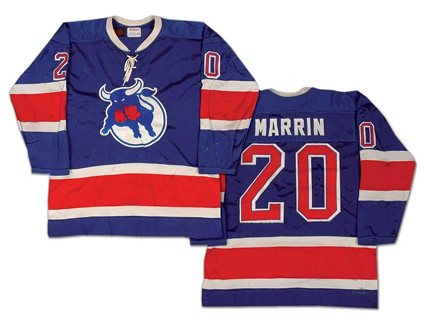
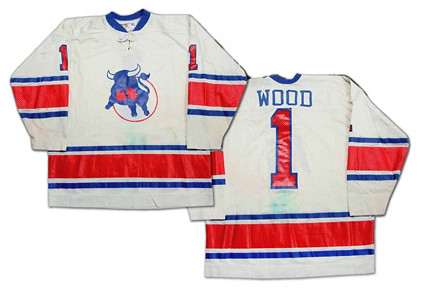
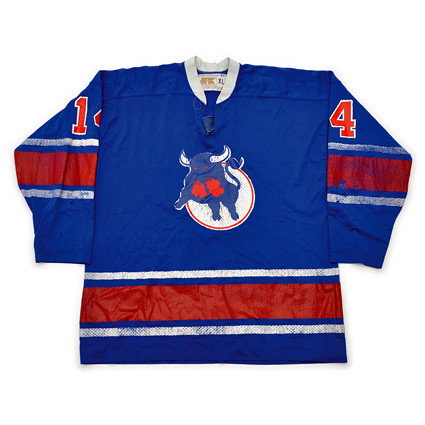
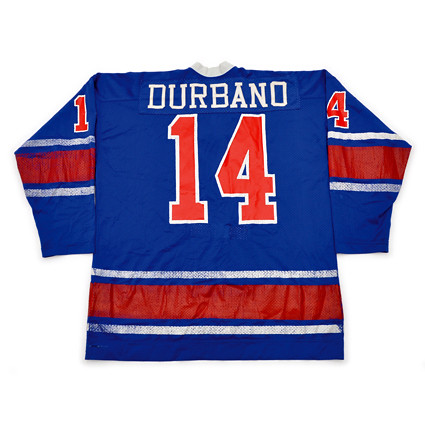
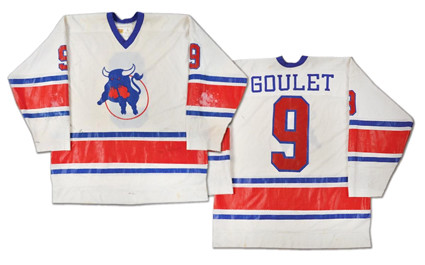
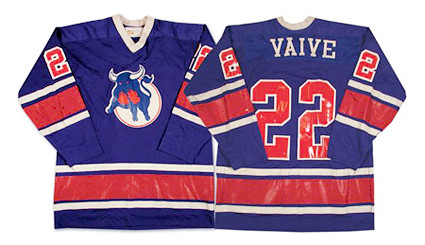










Thanks for the history. You'll be happy to know that yesterday, it was announced that the Birmingham Bulls will be coming back as a member of the Southern professional Hockey League starting this fall!
ReplyDelete